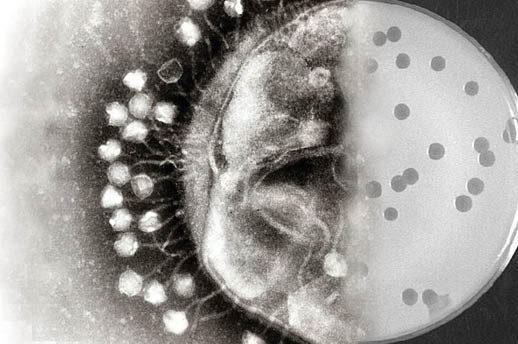
Transmission electron microscopy of bacteriophage viruses attached by their caudal fibers to the membrane of a bacterium. (Photo: Emily Brown, commons.wikimedia.org, CC BY-SA 3.0)
The politics of Amphibiosis*:
The war against viruses will not take place
“We are at war.” This was Emmanuel Macron’s chosen refrain when he addressed the French nation about the current COVID-19 pandemic. He is certainly not the first to present human/pathogenic microbe relations in this way. Indeed, the history of immunology and epidemiology is littered with the vocabulary of war. But this presidential rhetoric reveals a certain communication strategy based on national unity, a hackneyed but nevertheless effective argument that is perfectly in keeping with a neoliberal ideology, a context in which the life of society is a constant struggle.
This article was first published on 19.04.2020 at Somatosphere.net with the URL <http://somatosphere.net/2020/the-politics-of-amphibiosis.html/>. License: © Charlotte Brives, somatosphere.net Original (french): <https://www.lemediatv.fr/articles/points-de-vue/politiques-de-lamphibiose-la-guerre-contre-les-virus-naura-pas-lieu-ACcrS8oIQsOuLQmmvfx2aQ>
Info: *Amphibiose a term developed in the 1960s by microbiologist Theodor Rosebury to illustrate the changeable and dynamic nature of the relations maintained by different biological entities, depending on the place and time.
Who is at war, and against what?
For there to be a war, there needs to be an enemy. But while viruses can maintain close relations with humans, and under certain circumstances may even put their lives in danger, the definition of their intentions only commits those who claim to give it. It is important that the perspective of these humans never be reduced to a universal ‘us’, which would grant them permission to speak on behalf of others, whether that be entire countries, or the whole of humanity.
The difficulties we are facing today are underpinned by an inexactitude, a certain narrow-mindedness, which affects not only the global apprehension of viruses themselves, but also of the consequences brought about by any sudden outbreak of a pathogenic virus in human society. And yet, it is diversity which takes precedence amongst viruses, as well as in the variability of their interactions with other species, especially concerning the social consequences for humans. It is impossible to subscribe to this kind of narrative once one knows, for example, what certain viruses like bacteriophages (literally: bacteria eaters)[1] can offer humans.
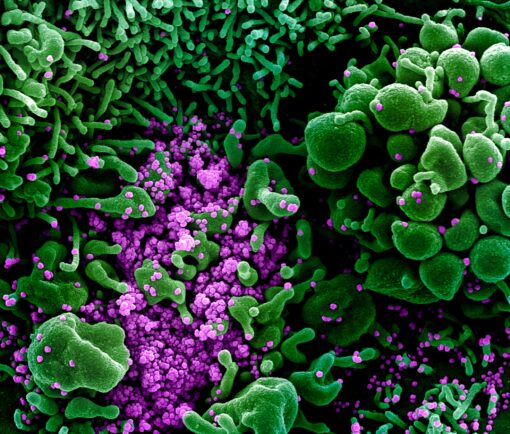
Colorized scanning electron micrograph of an apoptotic cell (green) heavily infected with SARS-COV-2 virus particles (purple), isolated from a patient sample. Image captured and colorenhanced at the NIAID Integrated Research Facility (IRF) in Fort Detrick, Maryland. Credit: NIAID
Bacterians and Bacteriophages
As bacteria become ever more resistant to antibiotics, such viruses can provide (and should be able to do so more and more in the future) treatment for bacterial infections which have become incurable via currently available chemical molecules. Bacteriophages are viruses that can provide relief to patients suffering from sometimes unbearable pain [2]. They have also contributed massively towards basic research, our understanding of DNA and how much scientists can manipulate it. [3]
Yet we do not pay enough attention to this evidence: viruses are all very different from one another. Every epidemic is different and takes on a variety of forms depending on the geographical, environmental and socio-political context. These entities, that vary hugely, but that we have grouped within one category named ‘viruses’, have the largest population of any entity in the living world. Their vastness in number defies the limits of our imagination. They are not an enemy we should be ‘at war’ against. Humans live biologically and socially with viruses and other microbes. This is irreversible and happens in many different ways, according to a wide spectrum of possible relations, of which pathogenicity is just one amongst many others.
Co-Existing with Viruses and Microbes
Human life, just like plant and animal life, is conditioned by the microbes which populate the body. These interdependencies exist everywhere.
We can think about them through the idea of “amphibiosis”, a term developed in the 1960s by microbiologist Theodor Rosebury [4] to illustrate the changeable and dynamic nature of the relations maintained by different biological entities, depending on the place and time. Let us take a well-known example from hospitals. The bacterium known as staphylococcus aureus [5], which is harmless when it resides inside a human nose (and is the case for 30% of humans) can cause an infection if it gets inside the knee following a surgical procedure. A second example is helicobacter pylori [6], a bacterium which causes stomach ulcers, but only at certain times (ulcer attacks happen intermittently, in patients usually aged between 30 and 60). Carriers are therefore not unwell all of the time.
Humans must adapt their organisation, or their politics, to the amphibiotic character of their relations with micro-organisms. These are changing relations, which are sometimes pathogenic, sometimes not, depending on conditions that need to be recognised. Since the discovery of variolation [7] and the principle of vaccination, up to and including current strategies in place for managing the HIV pandemic, the problem is not so much one of battling an invisible enemy, as it is about learning to live, to becoming with these biological entities which have their own modes of existence [8]. It’s less about preparing for the worst (even though emergency response plans for epidemics are of course necessary), as more about taking note of and learning from the consequences of this living together and of its shared futures.
Let us start then, by pondering the human point of view. The deceptive unification of situations, implicitly imposed by the war metaphor, confuses us on two levels.
SARS-CoV-2 kills; it destabilises bodies, populations, societies, governments, finance; it allows the cracks to show, makes class divisions obvious, and reveals weaknesses; it’s an anomaly which encourages us to question the everyday actions and interactions of societies, and to be alarmed at our leaders’ failings. Yes, it is and does all these things… and no, in fact, it doesn’t do any of these things. Because ‘these things’, are simply the way humans receive, endure or manage the virus’ outbreak into their world.
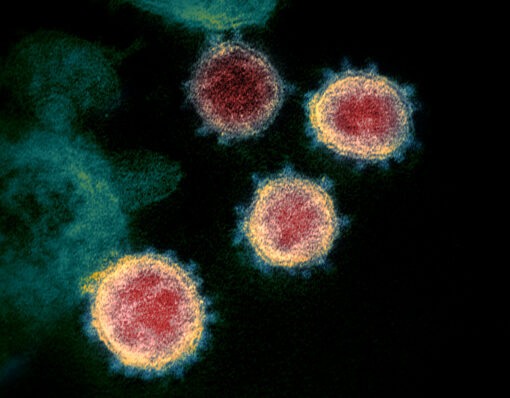
This transmission electron microscope image shows SARS-CoV-2—also known as 2019-nCoV, the virus that causes COVID-19—isolated from a patient in the U.S. Virus particles are shown emerging from the surface of cells cultured in the lab. The crown-like spikes on the outer edge of the virus particles give coronaviruses their name. Credit: NIAID-RML
In other words, ‘these things’ depend a lot on who, amongst us humans, is talking – and from what point of view. Many articles and comments on social media and elsewhere reveal the multiplicity of the virus. And it is important to emphasise the fact that the consequences of this virus’ ‘intrusion’ are extremely variable – depending on the state of an individual’s immune system, depending on social class, gender, race, the policies being followed by the relevant health system, the different ways a country has previously experienced epidemics, and so on.
This represents a first level of complexity: we can talk about a pandemic, but we could also talk about a multiplicity of epidemics. It’s important to listen to the stories which reveal the heterogeneity of the consequences, rather than subsume them into a single call for unity, silencing and rendering invisible each individual story (a strategy historically chosen by governments). Instead, it is time to turn our attention to what is usually disregarded, denied or hidden from view, and to the imbalance of power which is perpetuated, when, to the detriment of many others, one voice or another (the dominant ones) prioritise one line of conversation, one point of view.
A second and no doubt less obvious level of complexity concerns what we understand by the term ‘virus’. For scientists, viruses are ‘obligate parasites’, meaning they are entities which cannot survive without a host organism. A virus enters a specific cell within an organism which is itself specific, and uses the latter’s metabolic system to reproduce. Viruses have an incredible capacity to evolve. They mutate and adapt rapidly. Some of them can therefore cross ‘barriers’ between species and pass, for example, from chickens or pigs, to humans. But the relations they maintain with their hosts are highly varied and are far from always harmful to them. Some viruses have in fact been a driving force in the evolution of species. One example of this is in syncytin-1 [9], a protein needed to form the placenta (specific to mammals). Following infectious periods, genes of viral origin coding for syncytin-1 were integrated in the DNA of our mammalian ancestors, contributing to the emergence of the category of living beings to which humans belong. More widely, a non-negligible percentage of human DNA comes from viral infections. Is the war metaphor so appropriate here?
But let’s focus on viruses that are pathogenic to humans
Many people will know a certain number of them at least by name: HIV, influenza, SARS, Ebola, dengue, yellow fever, Hepatitis C, etc.
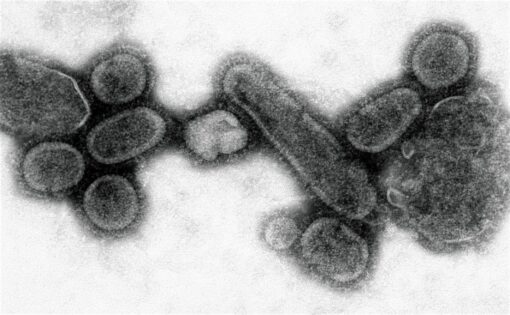
Electronic photograph of the 1918 virus retrospectively reconstituted by genetic engineering from samples of human remains from 1918. Credit: Cynthia Goldsmith, Content Providers(s): CDC/ Dr. Terrence Tumpey/ Cynthia Goldsmith
And yet most scientists known for their work on one or other of these viruses are reticent to speak publicly about COVID-19: “I specialise in this virus, or that virus, but not corona. I don’t know about it.” Happily, relevant continuities exist in the ways humans manage epidemics, and the knowledge acquired during one epidemic is precious for analysing reactions and anticipating the effects of another. The reason these scientists do not want to speak publicly is because the knowledge acquired about and with viruses has revealed the immense diversity of this group of entities that have been subsumed under one umbrella term (see this remarkable map of viruses, so vast it could be a map of the universe. [10]) “Virus” is not so much a term for a clearly defined object, as it is a type of “being in the world”. Modern science has classified them together only on the basis of a few behaviours and characteristics. To put it simply: a detailed examination of the Ebola virus, HIV and Sars-Cov-2 shows they have about as much in common as a pangolin, a sunflower and a bacterium; these are all living beings, but it wouldn’t occur to anybody to consider their modes of existence and the way in which humans interact (or not) with each of them as at all similar.
The interactions of different viruses with their hosts are just as varied. Among other dissimilarities, SARS-CoV-2 has very little in common with HIV or the Spanish influenza Virus in terms of its incubation period, its contagiousness, the time it can survive outside a host, the symptoms, the immune system’s reaction to it, even its mortality rate (which we will only know once the epidemic is over, provided that the majority of the cases could be collected). This explains why the immunologist, eminent HIV specialist and President of the COVID-19 Science Advisory Board put in place by the French government to shed light on the current epidemic, Professor Jean-François Delfraissy, defined the current situation as a “totally unprecedented situation” on 18th March 2020 on French radio network RTL. He said, “I’ve already witnessed several big health crises, such as HIV and Ebola, but the speed – and consequences – of COVID-19’s outbreak are extremely surprising.”
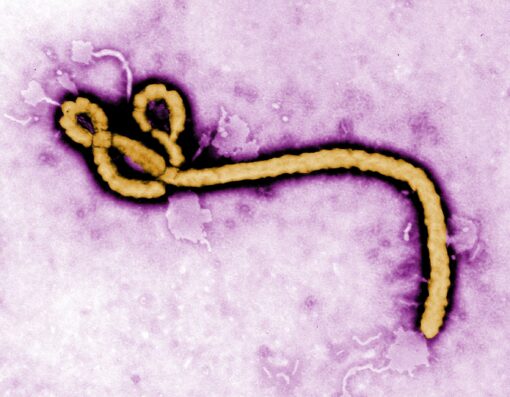
Colorized transmission electron microscopy of the Ebola virus. Credit: Frederick A. Murphy, CDC Global
Why is all this important at a time when many have been confined to their homes, where living conditions are extremely varied, and others must continue to go to work (to ensure the continuity of the population’s means of existence, but also to preserve the economic and financial interests of a small minority), when hospitals are overrun and political decisions are being taken under cover of an emergency health crisis that risk long-term harm to certain hard-fought-for legal rights and freedoms?
In a beautiful book on matsutake mushrooms [11], anthropologist Anna Tsing suggests her readers be aware of the precarity of our modes of existence. Precarity, she writes, is “life without the promise of stability”. One could argue that precarity is also the recognition of amphibiosis as a foundation for the relations between living things, in the context of which political and social choices should be made.
It is not against viruses that we should be waging a war, but against the political and economic systems which, far from being conceived as protection against the precarity (this itself being variable!) of human and non-human lives, use it and accentuate it because it is inherent and indispensable to the domination of neoliberalism and its way of operating. But these systems accelerate both the production of pathogenic agents, thanks to the industrialisation of farming and agriculture, and their dissemination, thanks to highly intensified exchanges within the general interconnectedness of spaces. Systemic standardization is incompatible with amphibiosis – with the amphibiotic condition of living beings.
Rather than wage war, why not reorganise the living – our living communities, the way we offer mutual aid and solidarity amongst humans and non-humans. Competition, which is so precious to Social Darwinism (which draws on an erroneous reading of Darwin) [12], is only one possibility among the regimes of relations between beings, and is certainly not the one with the greatest potential. Unless we move away from the ideals of Western modernity (huge challenges, important debates), non-human living entities will not be considered political, but the relations humans choose to maintain with them most definitely are. If there is any meaning to the idea of political ecology, it’s about seizing on the diversity of the common futures of humans and the multiplicity of other living entities, in order to establish other conceptions of living environments long devastated by current economic systems.
This will require using whatever administrative means necessary to act against the harmful effects of industry and mad financial logic, for example, and in favour of restoring adept public health services (with the budget and tax implications that entails). Our futures, which we necessarily share with others (human and non-human), depend on it. Because the next virus will be different. And our response to its emergence needs to be different as well.
Quellen:
[1] Bacteriophage, From Wikipedia, the free encyclopedia <https://en.wikipedia.org/wiki/Bacteriophage>
[2] Antibacterial applications of bacteriophages, Volume 24, issue 1, Janvier-Février 2020, John Libbey Eurotext, <https://www.jle.com/en/revues/vir/e-docs/les_applications_antibacteriennes_des_bacteriophages_316325/article.phtml?tab=texte>
[3] A century of research on bacteriophages, Volume 24, issue 1, Janvier-Février 2020, John Libbey Eurotext, <https://www.jle.com/en/revues/vir/e-docs/un_siecle_de_recherche_sur_les_bacteriophages_316330/article.phtml?tab=texte>
[4] Theodor Rosebury, From Wikipedia, the free encyclopedia <https://en.wikipedia.org/wiki/Theodor_Rosebury>
[5] Staphylococcus aureus From Wikipedia, the free encyclopedia <https://en.wikipedia.org/wiki/Staphylococcus_aureus>
[6] Helicobacter pylori, From Wikipedia, the free encyclopedia <https://en.wikipedia.org/wiki/Helicobacter_pylori>
[7] Variolation, From Wikipedia, the free encyclopedia, <https://en.wikipedia.org/wiki/Variolation>
[8] Charlotte Brives. From Fighting against to becoming with: viruses as companion species. 2017. HAL Id: hal-01528933, https://hal.archives-ouvertes.fr/hal-01528933, Preprint submitted on 1 Jun 2017 <https://www.academia.edu/38127591/From_fighting_against_to_becoming_with_viruses_as_companion_species_in_Jean_Denis_Vigne_et_Charles_St%C3%A9panoff_eds_Hybrid_Communities_Biosocial_Approaches_to_Domestication_and_Other_Trans_species_relationships_London_Routledge>
[9] Syncytin-1, From Wikipedia, the free encyclopedia <https://en.wikipedia.org/wiki/Syncytin-1>
[10] Virusmap, Université Lyon 2020 <http://virusmap.univ-lyon1.fr>
[11] The Mushroom at the End of the World: On the Possibility of Life in Capitalist Ruins,
Anna Lowenhaupt Tsing, Published: Sep 19, 2017, Princeton University Press, ISBN: 9780691178325 <https://press.princeton.edu/books/paperback/9780691178325/the-mushroom-at-the-end-of-the-world>
[12] Social Darwinism, From Wikipedia, the free encyclopedia <https://en.wikipedia.org/wiki/Social_Darwinism>
The politics of Amphibiosis*:
The war against viruses will not take place
This article was first published on 19.04.2020 at Somatosphere.net with the URL <http://somatosphere.net/2020/the-politics-of-amphibiosis.html/>. License: © Charlotte Brives, somatosphere.net Original (french): <https://www.lemediatv.fr/articles/points-de-vue/politiques-de-lamphibiose-la-guerre-contre-les-virus-naura-pas-lieu-ACcrS8oIQsOuLQmmvfx2aQ>

Transmission electron microscopy of bacteriophage viruses attached by their caudal fibers to the membrane of a bacterium. (Photo: Emily Brown, commons.wikimedia.org, CC BY-SA 3.0)
“We are at war.” This was Emmanuel Macron’s chosen refrain when he addressed the French nation about the current COVID-19 pandemic. He is certainly not the first to present human/pathogenic microbe relations in this way. Indeed, the history of immunology and epidemiology is littered with the vocabulary of war. But this presidential rhetoric reveals a certain communication strategy based on national unity, a hackneyed but nevertheless effective argument that is perfectly in keeping with a neoliberal ideology, a context in which the life of society is a constant struggle.
Info: *Amphibiose a term developed in the 1960s by microbiologist Theodor Rosebury to illustrate the changeable and dynamic nature of the relations maintained by different biological entities, depending on the place and time.
Who is at war, and against what?
For there to be a war, there needs to be an enemy. But while viruses can maintain close relations with humans, and under certain circumstances may even put their lives in danger, the definition of their intentions only commits those who claim to give it. It is important that the perspective of these humans never be reduced to a universal ‘us’, which would grant them permission to speak on behalf of others, whether that be entire countries, or the whole of humanity.
The difficulties we are facing today are underpinned by an inexactitude, a certain narrow-mindedness, which affects not only the global apprehension of viruses themselves, but also of the consequences brought about by any sudden outbreak of a pathogenic virus in human society. And yet, it is diversity which takes precedence amongst viruses, as well as in the variability of their interactions with other species, especially concerning the social consequences for humans. It is impossible to subscribe to this kind of narrative once one knows, for example, what certain viruses like bacteriophages (literally: bacteria eaters)[1] can offer humans.

Colorized scanning electron micrograph of an apoptotic cell (green) heavily infected with SARS-COV-2 virus particles (purple), isolated from a patient sample. Image captured and colorenhanced at the NIAID Integrated Research Facility (IRF) in Fort Detrick, Maryland. Credit: NIAID
Bacterians and Bacteriophages
As bacteria become ever more resistant to antibiotics, such viruses can provide (and should be able to do so more and more in the future) treatment for bacterial infections which have become incurable via currently available chemical molecules. Bacteriophages are viruses that can provide relief to patients suffering from sometimes unbearable pain [2]. They have also contributed massively towards basic research, our understanding of DNA and how much scientists can manipulate it. [3]
Yet we do not pay enough attention to this evidence: viruses are all very different from one another. Every epidemic is different and takes on a variety of forms depending on the geographical, environmental and socio-political context. These entities, that vary hugely, but that we have grouped within one category named ‘viruses’, have the largest population of any entity in the living world. Their vastness in number defies the limits of our imagination. They are not an enemy we should be ‘at war’ against. Humans live biologically and socially with viruses and other microbes. This is irreversible and happens in many different ways, according to a wide spectrum of possible relations, of which pathogenicity is just one amongst many others.
Co-Existing with Viruses and Microbes
Human life, just like plant and animal life, is conditioned by the microbes which populate the body. These interdependencies exist everywhere.
We can think about them through the idea of “amphibiosis”, a term developed in the 1960s by microbiologist Theodor Rosebury [4] to illustrate the changeable and dynamic nature of the relations maintained by different biological entities, depending on the place and time. Let us take a well-known example from hospitals. The bacterium known as staphylococcus aureus [5], which is harmless when it resides inside a human nose (and is the case for 30% of humans) can cause an infection if it gets inside the knee following a surgical procedure. A second example is helicobacter pylori [6], a bacterium which causes stomach ulcers, but only at certain times (ulcer attacks happen intermittently, in patients usually aged between 30 and 60). Carriers are therefore not unwell all of the time.
Humans must adapt their organisation, or their politics, to the amphibiotic character of their relations with micro-organisms. These are changing relations, which are sometimes pathogenic, sometimes not, depending on conditions that need to be recognised. Since the discovery of variolation [7] and the principle of vaccination, up to and including current strategies in place for managing the HIV pandemic, the problem is not so much one of battling an invisible enemy, as it is about learning to live, to becoming with these biological entities which have their own modes of existence [8]. It’s less about preparing for the worst (even though emergency response plans for epidemics are of course necessary), as more about taking note of and learning from the consequences of this living together and of its shared futures.
Let us start then, by pondering the human point of view. The deceptive unification of situations, implicitly imposed by the war metaphor, confuses us on two levels.
SARS-CoV-2 kills; it destabilises bodies, populations, societies, governments, finance; it allows the cracks to show, makes class divisions obvious, and reveals weaknesses; it’s an anomaly which encourages us to question the everyday actions and interactions of societies, and to be alarmed at our leaders’ failings. Yes, it is and does all these things… and no, in fact, it doesn’t do any of these things. Because ‘these things’, are simply the way humans receive, endure or manage the virus’ outbreak into their world.

This transmission electron microscope image shows SARS-CoV-2—also known as 2019-nCoV, the virus that causes COVID-19—isolated from a patient in the U.S. Virus particles are shown emerging from the surface of cells cultured in the lab. The crown-like spikes on the outer edge of the virus particles give coronaviruses their name. Credit: NIAID-RML
In other words, ‘these things’ depend a lot on who, amongst us humans, is talking – and from what point of view. Many articles and comments on social media and elsewhere reveal the multiplicity of the virus. And it is important to emphasise the fact that the consequences of this virus’ ‘intrusion’ are extremely variable – depending on the state of an individual’s immune system, depending on social class, gender, race, the policies being followed by the relevant health system, the different ways a country has previously experienced epidemics, and so on.
This represents a first level of complexity: we can talk about a pandemic, but we could also talk about a multiplicity of epidemics. It’s important to listen to the stories which reveal the heterogeneity of the consequences, rather than subsume them into a single call for unity, silencing and rendering invisible each individual story (a strategy historically chosen by governments). Instead, it is time to turn our attention to what is usually disregarded, denied or hidden from view, and to the imbalance of power which is perpetuated, when, to the detriment of many others, one voice or another (the dominant ones) prioritise one line of conversation, one point of view.
A second and no doubt less obvious level of complexity concerns what we understand by the term ‘virus’. For scientists, viruses are ‘obligate parasites’, meaning they are entities which cannot survive without a host organism. A virus enters a specific cell within an organism which is itself specific, and uses the latter’s metabolic system to reproduce. Viruses have an incredible capacity to evolve. They mutate and adapt rapidly. Some of them can therefore cross ‘barriers’ between species and pass, for example, from chickens or pigs, to humans. But the relations they maintain with their hosts are highly varied and are far from always harmful to them. Some viruses have in fact been a driving force in the evolution of species. One example of this is in syncytin-1 [9], a protein needed to form the placenta (specific to mammals). Following infectious periods, genes of viral origin coding for syncytin-1 were integrated in the DNA of our mammalian ancestors, contributing to the emergence of the category of living beings to which humans belong. More widely, a non-negligible percentage of human DNA comes from viral infections. Is the war metaphor so appropriate here?
But let’s focus on viruses that are pathogenic to humans
Many people will know a certain number of them at least by name: HIV, influenza, SARS, Ebola, dengue, yellow fever, Hepatitis C, etc.

Electronic photograph of the 1918 virus retrospectively reconstituted by genetic engineering from samples of human remains from 1918. Credit: Cynthia Goldsmith, Content Providers(s): CDC/ Dr. Terrence Tumpey/ Cynthia Goldsmith
And yet most scientists known for their work on one or other of these viruses are reticent to speak publicly about COVID-19: “I specialise in this virus, or that virus, but not corona. I don’t know about it.” Happily, relevant continuities exist in the ways humans manage epidemics, and the knowledge acquired during one epidemic is precious for analysing reactions and anticipating the effects of another. The reason these scientists do not want to speak publicly is because the knowledge acquired about and with viruses has revealed the immense diversity of this group of entities that have been subsumed under one umbrella term (see this remarkable map of viruses, so vast it could be a map of the universe. [10]) “Virus” is not so much a term for a clearly defined object, as it is a type of “being in the world”. Modern science has classified them together only on the basis of a few behaviours and characteristics. To put it simply: a detailed examination of the Ebola virus, HIV and Sars-Cov-2 shows they have about as much in common as a pangolin, a sunflower and a bacterium; these are all living beings, but it wouldn’t occur to anybody to consider their modes of existence and the way in which humans interact (or not) with each of them as at all similar.
The interactions of different viruses with their hosts are just as varied. Among other dissimilarities, SARS-CoV-2 has very little in common with HIV or the Spanish influenza Virus in terms of its incubation period, its contagiousness, the time it can survive outside a host, the symptoms, the immune system’s reaction to it, even its mortality rate (which we will only know once the epidemic is over, provided that the majority of the cases could be collected). This explains why the immunologist, eminent HIV specialist and President of the COVID-19 Science Advisory Board put in place by the French government to shed light on the current epidemic, Professor Jean-François Delfraissy, defined the current situation as a “totally unprecedented situation” on 18th March 2020 on French radio network RTL. He said, “I’ve already witnessed several big health crises, such as HIV and Ebola, but the speed – and consequences – of COVID-19’s outbreak are extremely surprising.”

Colorized transmission electron microscopy of the Ebola virus. Credit: Frederick A. Murphy, CDC Global
Why is all this important at a time when many have been confined to their homes, where living conditions are extremely varied, and others must continue to go to work (to ensure the continuity of the population’s means of existence, but also to preserve the economic and financial interests of a small minority), when hospitals are overrun and political decisions are being taken under cover of an emergency health crisis that risk long-term harm to certain hard-fought-for legal rights and freedoms?
In a beautiful book on matsutake mushrooms [11], anthropologist Anna Tsing suggests her readers be aware of the precarity of our modes of existence. Precarity, she writes, is “life without the promise of stability”. One could argue that precarity is also the recognition of amphibiosis as a foundation for the relations between living things, in the context of which political and social choices should be made.
It is not against viruses that we should be waging a war, but against the political and economic systems which, far from being conceived as protection against the precarity (this itself being variable!) of human and non-human lives, use it and accentuate it because it is inherent and indispensable to the domination of neoliberalism and its way of operating. But these systems accelerate both the production of pathogenic agents, thanks to the industrialisation of farming and agriculture, and their dissemination, thanks to highly intensified exchanges within the general interconnectedness of spaces. Systemic standardization is incompatible with amphibiosis – with the amphibiotic condition of living beings.
Rather than wage war, why not reorganise the living – our living communities, the way we offer mutual aid and solidarity amongst humans and non-humans. Competition, which is so precious to Social Darwinism (which draws on an erroneous reading of Darwin) [12], is only one possibility among the regimes of relations between beings, and is certainly not the one with the greatest potential. Unless we move away from the ideals of Western modernity (huge challenges, important debates), non-human living entities will not be considered political, but the relations humans choose to maintain with them most definitely are. If there is any meaning to the idea of political ecology, it’s about seizing on the diversity of the common futures of humans and the multiplicity of other living entities, in order to establish other conceptions of living environments long devastated by current economic systems.
This will require using whatever administrative means necessary to act against the harmful effects of industry and mad financial logic, for example, and in favour of restoring adept public health services (with the budget and tax implications that entails). Our futures, which we necessarily share with others (human and non-human), depend on it. Because the next virus will be different. And our response to its emergence needs to be different as well.
Quellen:
[1] Bacteriophage, From Wikipedia, the free encyclopedia <https://en.wikipedia.org/wiki/Bacteriophage>
[2] Antibacterial applications of bacteriophages, Volume 24, issue 1, Janvier-Février 2020, John Libbey Eurotext, <https://www.jle.com/en/revues/vir/e-docs/les_applications_antibacteriennes_des_bacteriophages_316325/article.phtml?tab=texte>
[3] A century of research on bacteriophages, Volume 24, issue 1, Janvier-Février 2020, John Libbey Eurotext, <https://www.jle.com/en/revues/vir/e-docs/un_siecle_de_recherche_sur_les_bacteriophages_316330/article.phtml?tab=texte>
[4] Theodor Rosebury, From Wikipedia, the free encyclopedia <https://en.wikipedia.org/wiki/Theodor_Rosebury>
[5] Staphylococcus aureus From Wikipedia, the free encyclopedia <https://en.wikipedia.org/wiki/Staphylococcus_aureus>
[6] Helicobacter pylori, From Wikipedia, the free encyclopedia <https://en.wikipedia.org/wiki/Helicobacter_pylori>
[7] Variolation, From Wikipedia, the free encyclopedia, <https://en.wikipedia.org/wiki/Variolation>
[8] Charlotte Brives. From Fighting against to becoming with: viruses as companion species. 2017. HAL Id: hal-01528933, https://hal.archives-ouvertes.fr/hal-01528933, Preprint submitted on 1 Jun 2017 <https://www.academia.edu/38127591/From_fighting_against_to_becoming_with_viruses_as_companion_species_in_Jean_Denis_Vigne_et_Charles_St%C3%A9panoff_eds_Hybrid_Communities_Biosocial_Approaches_to_Domestication_and_Other_Trans_species_relationships_London_Routledge>
[9] Syncytin-1, From Wikipedia, the free encyclopedia <https://en.wikipedia.org/wiki/Syncytin-1>
[10] Virusmap, Université Lyon 2020 <http://virusmap.univ-lyon1.fr>
[11] The Mushroom at the End of the World: On the Possibility of Life in Capitalist Ruins,
Anna Lowenhaupt Tsing, Published: Sep 19, 2017, Princeton University Press, ISBN: 9780691178325 <https://press.princeton.edu/books/paperback/9780691178325/the-mushroom-at-the-end-of-the-world>
[12] Social Darwinism, From Wikipedia, the free encyclopedia <https://en.wikipedia.org/wiki/Social_Darwinism>



